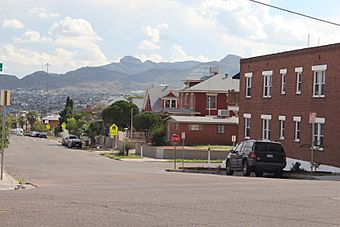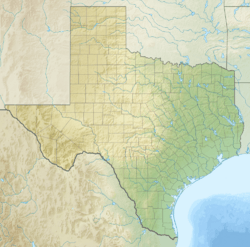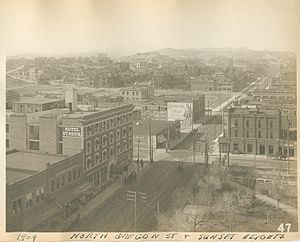Sunset Heights facts for kids
Quick facts for kids |
|
|
Sunset Heights Historic District
|
|

Home in Sunset Heights
|
|
| Location | Roughly bounded by Heisig Ave., River Ave., N. El Paso St., and I-10, El Paso, Texas |
|---|---|
| Area | 170 acres (69 ha) |
| Architect | Henry C. Trost, et al. |
| Architectural style | Tudor Revival, Mission/Spanish Revival, Classical Revival |
| NRHP reference No. | 88002672 |
| Added to NRHP | December 8, 1988 |
Sunset Heights is a historic neighborhood in El Paso, Texas. It has been around since the late 1890s. Many wealthy families built their large homes and mansions on this hill. While some homes have been beautifully restored, others have fallen into disrepair. A group called the Sunset Heights Improvement Association helps neighbors with home repairs. They also host a yearly tour of the area.
Contents
Discovering Sunset Heights' Past
How the Neighborhood Began
A man named John Fisher Satterthwaite started buying land here in the 1880s. By 1885, he had built 90 houses. Back then, the area was known as the "Satterthwaite Addition." He lost ownership of the land in 1894.
The name "Sunset Heights" was chosen in 1901. The local newspaper, the El Paso Herald, held a contest to find the best name for the neighborhood.
Secret Tunnels and Famous Visitors
Some buildings in Sunset Heights have old tunnels underneath them. These tunnels might have been started in the early 1900s. Tunnels found under places like El Paso High School may have been used for people to move secretly. This was especially true for Chinese workers who were not allowed into the United States because of the Chinese Exclusion Act of 1882. One well-known tunnel is under a house called the Turtle House in Sunset Heights.
During the Mexican Revolution in the 1910s, many rich Mexican families moved to Sunset Heights. A famous Mexican revolutionary leader, Francisco "Pancho" Villa, even owned a home here in the 1910s. In 1915, a house in Sunset Heights, designed by Trost & Trost, was used for a meeting between General Hugh L. Scott and Pancho Villa.
Sunset Heights was a very popular and stylish neighborhood until the time of the Great Depression.
Becoming a Historic Place
In 1984, Sunset Heights was officially named a historic district. This happened with the help of a person named John Karr. In 2003, the Sunset Heights Neighborhood Association began offering tours. These tours, called the Sunset Heights Tour, show off the historic areas and homes.
Exploring Sunset Heights Today
What the Neighborhood Looks Like
Sunset Heights is about one mile long and one and a half miles wide. Because it is a historic district, people who live there must follow special building rules. The blocks in the neighborhood come in different shapes. The houses are built in many styles, including American Foursquare, Tudor Revival, Classical Revival, Queen Anne, and Spanish Colonial Revival.
Where Sunset Heights Is Located
Interstate 10 forms the southern and western edges of the neighborhood. Schuster Avenue is the northern border, and Mesa Street is the eastern border.




